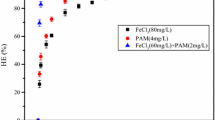Abstract
In this article it is proven that ultrasound can be used to harvest microalgae. The separation process is based on gentle acoustically induced aggregation followed by enhanced sedimentation. In this paper, the efficiency of harvesting and the concentration factor of the ingoing biomass concentration are optimized and the relevance of this process compared to other harvesting processes is determined. For the optimisation, five parameters were modeled simultaneously by the use of an experimental design. An experimental design was chosen, because of possible interaction effects between the different parameters. The efficiency of the process was modeled with a R-squared of 0.88. The ingoing flow rate and the biomass concentration had a lot of influence on the efficiency of the process. Efficiencies higher than 90% were reached at high biomass concentrations and flow rates of 4–6 L day−1. At most, 92% of the organisms could be harvested and a concentration factor of 11 could be achieved at these settings. It was not possible to harvest this microalga with higher efficiencies due to its small size and its small density difference with water. The concentration factor of the process was modeled with a R-squared of 0.75. The ingoing flow rate, biomass concentration and ratio between harvest flow and ingoing flow rate had a significant effect on the concentration factor. Highest concentration factors, up to 20, could be reached at low biomass concentrations and low harvest flows. On industrial scale, centrifuges can better be used to harvest microalgae, because of lower power consumption, better efficiencies and higher concentration factors. On lab- or pilot-plant scale, an ultrasonic harvesting process has the advantages that it can be operated continuously, it evokes no shear stress and the occupation space is very small. Also, when the algae excrete a soluble high valued product this system can be used as a biofilter.
Similar content being viewed by others
References
Bierau H., Perani A., Al-Rubeai M. and Emery A.N. 1998. A comparison of intensive cell culture bioreactors operating with Hybridomas modified for inhibited apoptotic response. J. Biotechnol. 62: 195-207.
Coakley W.T., Hawkes J.J., Sobanski M.A., C ousins C.M. and Spengler J. 2000. Analytical scale ultrasonic standing wave manipulation of cells and microparticles. Ultrasonics 38: 638-641.
Doblhoff-Dier O., Gaida T. and Katinger H. 1994. A novel ultrasonic resonance field device for the retention of animal cells. Biotechnol. Progr. 10: 428-432.
Gröschl M. 1998. Ultrasonic Separation of Suspended Particles - Part I: Fundamentals. Acust. Acta Acust. 84: 432-447. Gröschl M., Burger W., Handl B.
Doblhoff-Dier O., Gaida T. and Schmatz C. 1998. Ultrasonic Separation of Suspended Particles - Part III: Application in Biotechnology. Acust. Acta. Acust. 84: 815-822.
Haaland P.D. 1989. Experimental Design in Biotechnology. Marcel Dekker Inc., New York and Basel, 259 pp.
Hawkes J.J. and Coakley W.T. 1996. A continuous flow ultrasonic cell-filtering method. Enzyme Microb. Technol. 19: 57-62.
Hawkes J.J., Limaye M.S. and Coakley W.T. 1997. Filtration of bacteria and yeast by ultrasound-enhanced sedimentation. J. appl. Microbiol. 82: 39-47.
Kashyap S., Sundararajan A. and Lu-Kwang J. 1998. Flotation characteristics of cyanobacterium Anabaena flos-aquae for gas vesicle production. Biotechnol. Bioengng. 60: 636-641.
Kilburn D.G., Clarke D.J., Coakley W.T. and Bardsley D.W. 1989. Enhanced sedimentation of mammalian cells following acoustic aggregation. Biotechnol. Bioengng. 34: 559-562.
Kubitschek H.E. 1984. Independence of buoyant cell density and growth rate in Escherichia coli. J. Bact. 158: 296-299.
Kubitschek H.E. 1987. Buoyant density variation during the cell cycle in microorganisms. Crit. Rev. Microbiol. 14: 73-97.
Myers R.H. and Montgomery D.C. 1995. Response Surface Methodology: Process and Product Optimization Using Designed Experiments. John Wiley & Sons, New York, NY, USA.
Rippka R., Deruelles J., Waterbury J.B., Herdman M. and Stanier R.Y. 1979. Generic assignments, strain histories and properties of pure cultures of cyanobacteria. J. gen. Microbiol. 111: 1-61.
Ryll T., Dutina G., Reyes A., Gunson J., Krummen L. and Etcheverry T. 2000. Performance of small-scale CHO perfusion cultures using an acoustic cell filtration device for cell retention: Characterization of separation efficiency and impact of perfusion on product quality. Biotechnol. Bioengng. 69: 440-449.
Spengler J. and Jekel M. 2000. Ultrasound conditioning of suspensions - studies of streaming influence on particle aggregration on a lab-and pilot-plant scale. Ultrasonics 38: 624-628.
Trampler F., Sonderhoff S.A., Pui P.W.S., Kilburn D.G. and Piret J.M. 1994. Acoustic cell filter for high density perfusion culture of hybridoma cells. Bio/Technology 12: 281-284.
Van den Berg H., Oudshoorn A., Trampler F. and Keijzer T. 2001. High density cell cultures in perfusions. A perspective for vaccine production? BIOforum International 5: 37-38.
Winkelmeier P., Glauner B. and Lindl T. 1993. Quantification of cytotoxicity by cell volume and cell profileration. ATLA 21: 269-280.
Zhang J., Collins A., Chen M., Knyazev I. and Gentz R. 1998. High-Density Perfusion Culture of Insect Cells with a BioSep Ultrasonic Filter. Biotechnol. Bioengng. 59: 351-359.
Author information
Authors and Affiliations
Rights and permissions
About this article
Cite this article
Bosma, R., van Spronsen, W.A., Tramper, J. et al. Ultrasound, a new separation technique to harvest microalgae. Journal of Applied Phycology 15, 143–153 (2003). https://doi.org/10.1023/A:1023807011027
Issue Date:
DOI: https://doi.org/10.1023/A:1023807011027




